일상에서 피어나는 예술, 사회를 사유하는 시선 컨템포러리 아티스트 – 실라스 퐁
Art Emerging from the Everyday, A Gaze that Reflects on Society Contemporary Artist - Silas Fong
Localler
새롭게 떠오르는 문화를 발견해 융합해 나가는 ‘문화의 선구자 Culture Vanguard’ 역시 기아 디자인 크리에이티브 철학의 문화적 특징 중 하나입니다. 기아디자인매거진은 Localler라는 메뉴를 통해 ‘문화의 선구자 Culture Vanguard’라는 타이틀로 한국에서 살고 있는 현지 외국인, 외국에서 살고 있는 현지 한국인들의 경계 없는 스토리를 보여줍니다.
Localler
Culture Vanguard, who discovers and integrates emerging cultures, is another cultural feature of Kia Design’s creative philosophy. Kia Design Magazine presents the stories of foreigners living in Korea, local Koreans living abroad, and local Koreans living in foreign countries under the title of “Culture Vanguard” through the Localler menu.
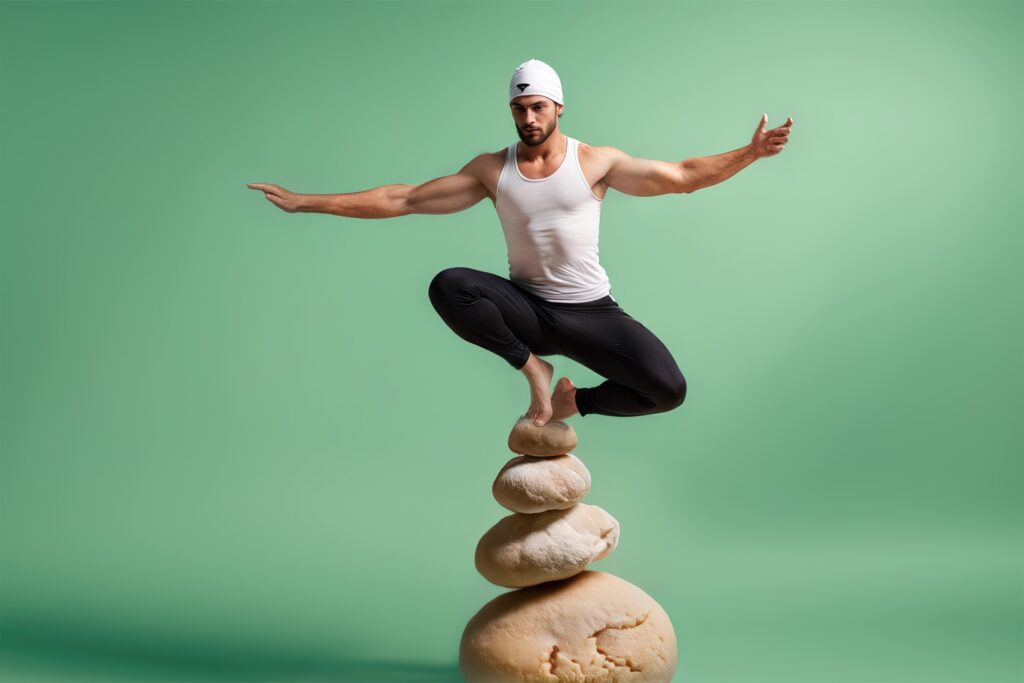
어디에도 완전히 속하지 않은 사람. 실라스 퐁Silas Fong은 홍콩, 독일, 한국 어디서든 늘 경계에 서 있었습니다. 그래서 스스로를 ‘영원한 경계인(border crosser)’이라 부릅니다. 그의 예술은 바로 이 경계에서 피어납니다. 그에게 예술가란 관찰자이자 동시에 참여자입니다. 사회를 멀리서 바라보기 위해 거리를 두는 한편, 그 안에서 살아가는 사람으로서 가까이 다가가는 태도도 놓치지 않습니다. 이 모순적 위치가 그의 작업에 독특한 시선을 불어넣습니다.
실라스 퐁은 일상의 작은 행위에서 영감을 얻습니다. 마트에서 건네 받은 파 한 단, 편의점 점원이 묻는 “봉투 필요하세요?” 같은 순간도 그의 작업 안에서는 사회적 관계를 읽어내는 기호가 됩니다. 그는 ‘바깥’과 ‘안’을 동시에 살아가며, 그 사이에 생기는 균열과 긴장을 예술로 만들어냅니다.
《기아 디자인 매거진》 16호 Localler는 경계인으로서의 삶이 불안하지만, 동시에 새로운 가능성을 발견하는 실라스 퐁의 항해를 담았습니다. 여기에서 그는 컨템포러리 예술가로서, 세계와 지역 사이를 가로지르며 관계와 시간을 다시 사유하는 방법을 보여줍니다.Someone who never fully belongs anywhere. Silas Fong has always stood at the threshold between places, Hong Kong, Germany, and Korea. He calls himself a “permanent border crosser,” and it is from this in-between space that his art emerges. For Fong, an artist is both an observer and a participant. He keeps a certain distance to look at society clearly, yet stays close enough to feel its pulse as one who lives within it. This tension between proximity and separation gives his work its distinctive perspective.
Silas Fong finds inspiration in the smallest gestures of everyday life. A bundle of green onions handed over at a market, or a convenience store clerk asking “Do you need a bag?” become signs through which he reads the structures of social relationships. Living both inside and outside, he turns the cracks and tensions between the two into art.
Kia Design Magazine Vol.16 Localler presents the journey of Silas Fong, whose life as a border crosser is marked by both uncertainty and discovery. Through his work he shows how contemporary art can bridge the gap between the global and the local, offering new ways to rethink connection, time, and belonging.
- 누구에게나 열려 있는 것,
예술 - 예술은 사회와 사람,
그리고 관계를 맺는 것 - 경계에 선 예술가,
한국을 향한 탐구시간
- Something Open to Everyone,
Art - Art is about connecting with society,
with people, and with relationships - An Artist on the Threshold,
A Time of Exploration Toward Korea
Editor’s Note
실라스 퐁은 비디오 아티스트로 출발했지만, 지금은 지역과 교감하는 컨템포러리 아티스트로 성장했습니다. 그는 음식과 돌봄이라는 가장 일상적인 주제를 통해 사람들과 연결되며, 예술을 삶의 현장 속으로 끌어옵니다. 빵을 굽고 나누는 행위, 식탁에서의 대화는 그의 작업 안에서 모두 예술적 경험으로 변환됩니다.
그가 추구하는 건 거창한 선언이 아니라 문턱을 낮춘 예술입니다. 예술은 어려운 것이 아니며, 누구나 함께 누릴 수 있어야 한다는 신념 아래 그는 프로젝트를 이어갑니다. 작은 제스처와 일상의 순간에서 관계를 발견하고, 그것을 작품으로 확장하는 방식은 관객에게도 자연스럽게 참여할 수 있는 공간을 열어줍니다.
《기아 디자인 매거진》 VOL.16 Localler는 경계 위에서 살아가면서도, 지역 사회와 직접 호흡하며 예술을 일상의 언어로 풀어내는 실라스 퐁의 여정 속에서 그가 정의하는 ‘예술’이 무엇인지를 함께 느껴보시기 바랍니다.
Editor’s Note
Silas Fong began his career as a video artist and has since developed into a contemporary artist deeply engaged with local communities. Through the most familiar subjects, such as food and care, he connects with people and brings art into the space of everyday life. Acts like baking and sharing bread or conversations held around a dining table become artistic experiences within his work.
What he seeks is not grand statements but art that lowers its threshold. Guided by the belief that art should not be difficult and must be something everyone can share, he continues his projects with sincerity and openness. By discovering relationships in small gestures and moments of daily life and expanding them into his work, Fong creates spaces where audiences can naturally participate.
Kia Design Magazine Vol.16 Localler invites readers to experience how Silas Fong, who lives on the boundaries yet breathes directly with his community, defines art as a language of everyday life and connection.
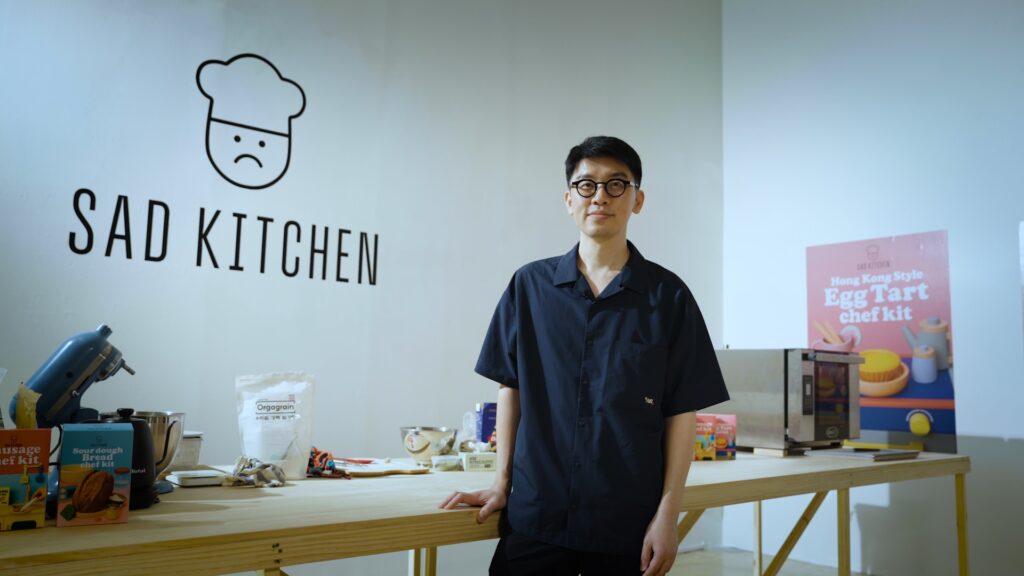
Chapter 01.
누구에게나 열려 있는 것,
예술
Chapter 01.
Something Open to Everyone,
Art
강릉 대추무파인아트에 들어서면 따뜻한 빵 냄새가 전시장을 가득 메운다. 《키친노트》라는 제목의 이번 전시는 음식이라는 가장 일상적인 소재를 통해 삶과 관계, 그리고 나눔의 의미를 탐구한다. 작가 실라스 퐁은 지역 장인들의 손끝에서 전해지는 정성과 기술, 그리고 자신이 직접 마주한 순간들을 작품 속에 녹여냈다.
빵과 소시지는 단순한 먹거리를 넘어 사람과 사람을 잇는 매개로 확장된다. 관객은 단순히 눈으로 작품을 감상하는 데 그치지 않는다. 함께 만들고 나누는 과정 속에서, 예술이 품은 따뜻한 가능성을 몸소 체험하게 된다.
퐁은 이렇게 설명한다.
“보통 전시는 작품이 걸려 있으면 끝이죠. 하지만 퍼포먼스를 하면 직접 사람을 만나고, 함께 음식을 만들며 그 자리에서 반응을 나눌 수 있어요. 저는 그 순간이야말로 예술의 본질이라고 생각합니다.”
실라스 퐁은 강릉의 작은 빵집과 소시지 가게를 직접 찾아 배우고, 그 경험을 전시장으로 옮겼다. 낯선 예술가의 요청을 흔쾌히 받아들인 지역 주민들의 따뜻한 마음은 그에게 깊은 울림을 주었다. 그는 덧붙인다.
“빵을 굽고 나누는 행위 자체가 이미 관대함을 품고 있더군요.”
그의 작업은 늘 지역성과 일상에서 출발한다. 시장에서 건네받은 작은 친절, 마주친 풍경 속 사람들의 모습이 그의 손끝에서 예술의 언어로 다시 태어난다. 퐁은 예술을 제도나 무대 위의 특별한 사건으로 한정하지 않는다. 오히려 누구나 함께 나눌 수 있는 일상의 경험으로 되돌리려 한다. 이 지점은 그의 예술 세계를 지탱하는 가장 확고한 원칙이다.
When you step into Dae-Chum-Mu Fine Art in Gangneung, the scent of freshly baked bread fills the air. The exhibition titled Kitchen Note explores life, relationships, and the meaning of sharing through the most familiar subject, food. Artist Silas Fong weaves into his works the devotion and skill of local artisans as well as the moments he has personally encountered in the community.
Bread and sausage transcend their role as mere sustenance, transforming into mediums that connect people. Visitors are not passive observers. Through the act of making and sharing, they directly experience the warmth and potential of art.
Fong explains,
“Usually, an exhibition ends once the artworks are hung. But through performance, I can meet people in person, make food together, and share reactions in real time. To me, that moment is the very essence of art.”
He personally visited local bakeries and sausage shops in Gangneung to learn their crafts, bringing those experiences into the exhibition space. The generosity of the local residents, who welcomed a stranger’s artistic request, deeply moved him. “The act of baking and sharing bread already contains generosity,” he adds.
Fong’s work always begins with the local and the everyday. Small gestures of kindness exchanged in the market or fleeting encounters with people in familiar landscapes are reborn through his hands into the language of art. He does not see art as an institution or a staged event but as a shared experience that belongs to everyone. This belief, that art must return to daily life, remains the most fundamental principle sustaining his artistic world.
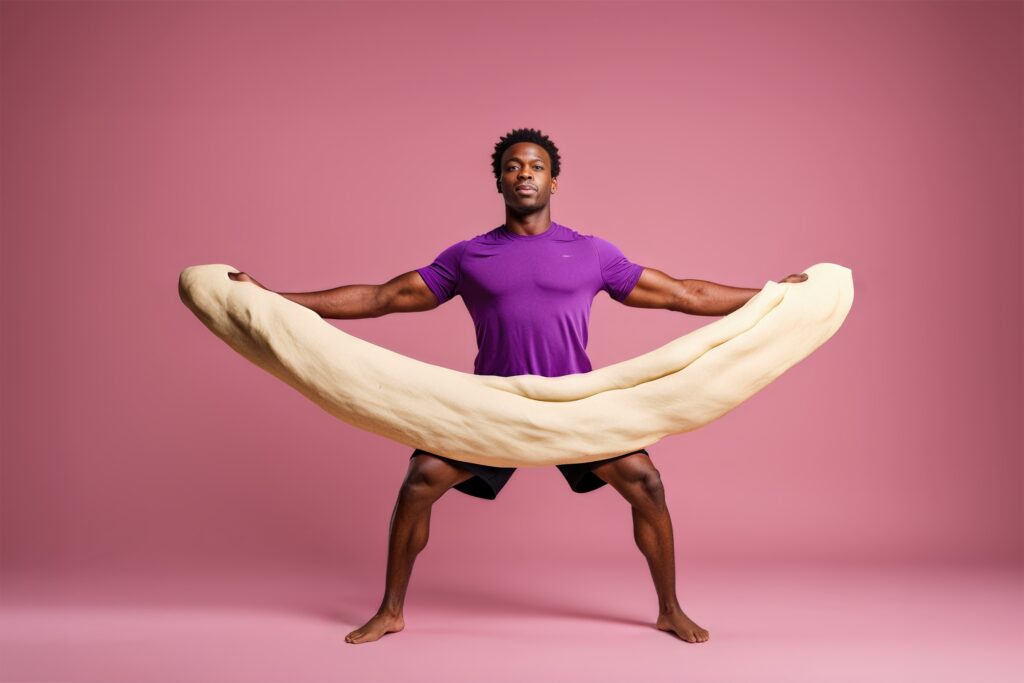
2020년 청주시립미술관에서 열린 《내일의 미술가들 – 누구에겐 그럴 수 있는》에서 실라스 퐁은 자신의 태도를 가장 솔직하게 드러냈다. 그는 ‘키친–비넨슈티히SAD Kitchen–Bienenstich’라는 제목 아래 두 개의 영상을 선보였다. 하나는 낯선 도시에서 살아가는 예술가들을 인터뷰하며 그들이 힘들거나 지쳤을 때 떠올리는 위안의 음식을 묻는 작업이었다. 다른 하나는 그가 직접 주방에서 요리하는 모습을 기록한 영상이었다.
At the 2020 Artists of Tomorrow exhibition, It Could Be for Someone at the Cheongju Museum of Art, Silas Fong revealed his artistic stance in its most honest form. Under the title SAD Kitchen Bienenstich, he presented two video works. One featured interviews with artists living in unfamiliar cities, asking them what comfort food they think of when they feel exhausted or discouraged. The other recorded Fong himself cooking in the kitchen, turning that everyday act into part of his artistic process.

퐁은 이 작업을 통해 “예술은 누구에게나 열려 있다”는 메시지를 전하고자 했다. 그는 《SAD 예술가직업훈련학교, 빵학과》에서 그 생각을 더욱 구체화했다. 전시장에 설치된 ‘Flourglass’는 관객을 반복적인 기술 연습 속으로 이끌며, 우리가 당연하게 여기는 성취와 검증의 기준이 얼마나 자의적일 수 있는지를 보여준다. 또 다른 작품인 ‘Shape and Score Clinic’은 정해진 규칙에 따라 동일한 행위를 반복하게 하며, 제도가 창의성을 어떻게 제한하는지를 자연스럽게 체감하게 한다.
“학교라기보다는 생존 매뉴얼에 가까웠습니다. 결국 제가 던진 질문은 ‘우리는 어떤 예술가가 되고 싶은가?’였죠. 저는 예술을 특별한 재능으로 증명하는 것이 아니라, 일상의 과정 속에서 스스로 선택하고 만들어가는 일이라고 생각합니다. 빵을 굽거나 음식을 나누는 경험처럼, 사소한 행위도 예술의 시작이 될 수 있다고 믿습니다.”
Through this work, Fong sought to convey the message that art is open to everyone. He developed this idea further in SAD Artist Vocational Training School, Department of Bread. The installation Flourglass invited viewers into a cycle of repetitive skill practice, revealing how arbitrary our notions of achievement and validation can be. Another work, Shape and Score Clinic, required participants to repeat identical actions according to fixed rules, allowing them to feel firsthand how institutional systems can constrain creativity.
“It was closer to a survival manual than a school,” Fong reflects. “The question I wanted to ask was, what kind of artist do we want to become? I do not see art as something proven through special talent, but as something we choose and create within the course of everyday life. Like the experience of baking bread or sharing a meal, even the simplest act can become the beginning of art.”
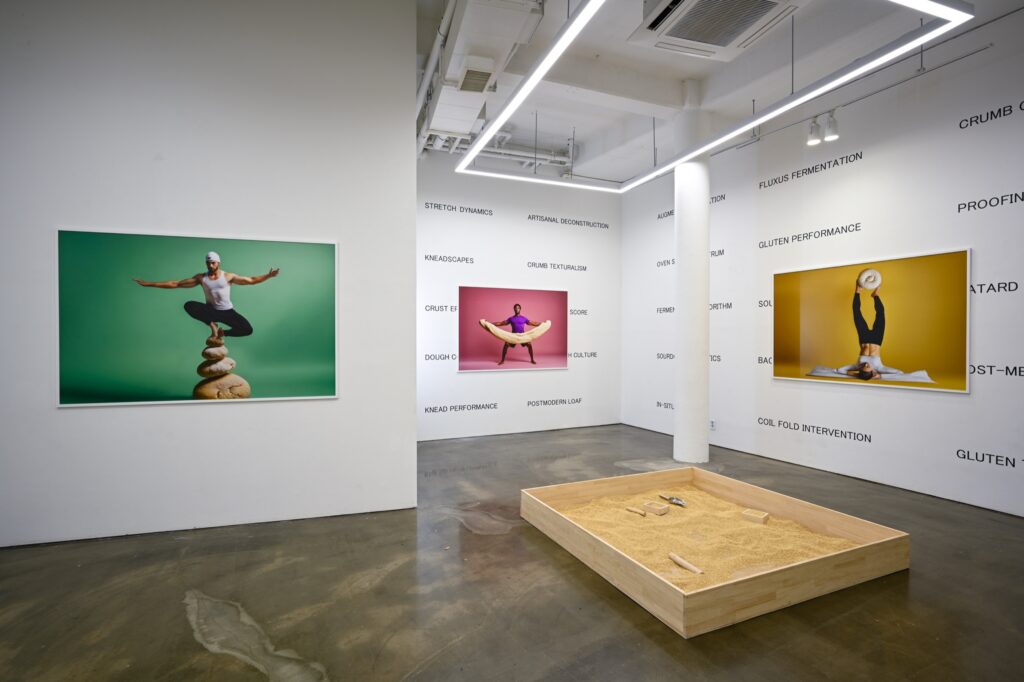
Chapter 02.
예술은 사회와 사람,
그리고 관계를 맺는 것
Chapter 02.
Art is about connecting with society,
with people, and with relationships
그렇다면 왜 그는 한국에서 유독 ‘음식’을 매개로 작업을 이어가고 있을까. 그 답은 2022년 팬데믹 시기로 거슬러 올라간다. 당시 레지던시에 머물던 그는 작업실을 온라인으로 공개해야 했지만, 보여줄 만한 장면이 마땅치 않았다. 하루 대부분은 요리하고, 씻고, 먹는 일상이었기 때문이다. 그러나 바로 그 평범한 순간 속에서 그는 예술가 역시 음식을 통해 건강해지고, 타인과 관계를 만들어갈 수 있다는 사실을 새삼 깨달았다.
“한국에서 몇 년을 살다 보니 건축이나 음식 같은 구체적인 소재를 넘어 결국 중요한 것은 ‘관계’라는 걸 알게 되었습니다. 한국 사회가 관계를 맺는 방식, 그리고 그 안에서 제가 경험한 친절함이 제 작업에도 자연스럽게 스며들었죠. 사실 저는 원래 아주 친절한 사람은 아닙니다. 그래서 작업을 시작할 때는 대체로 비판적인 시점에서 출발합니다. 그런데 음식을 매개로 하다 보니, 의도하지 않아도 친절함이 드러난다는 사실을 깨달았어요. 누군가에게 음식을 건네는 행위는 단순한 표현이 아니라, 나눔과 감사의 관계를 만들어내는 일입니다. 그래서 저에게 음식은 특별한 매체가 됩니다.”
Why, then, does he continue to work with the theme of food, particularly in Korea? The answer goes back to 2022, during the pandemic. At the time, while staying in an artist residency, he had to present his studio online, yet there was little to show. Most of his days were spent cooking, washing, and eating. In those ordinary routines, he realized that artists, too, can nurture themselves and build relationships through food.
“After living in Korea for several years, I came to understand that beyond specific subjects like architecture or food, what truly matters is relationships,” he explains. “The way Korean society forms connections, and the kindness I’ve experienced within those relationships, have naturally influenced my work. I am not, by nature, a particularly gentle person. I usually begin my projects from a more critical perspective. But through food, I found that kindness appears even when it is not intended. Offering food to someone is not just a gesture of expression; it is an act of creating a relationship built on sharing and gratitude. That is why, for me, food has become a special medium.”

이러한 태도는 그의 초기 작업과도 맞닿아 있다. 실라스 퐁은 예술이 사회와 사람, 그리고 관계를 맺는 과정이라는 믿음 아래, 오래전부터 일상 속 장면을 통해 사회 구조를 질문해왔다. 2008년부터 2010년까지 이어진 ‘Stolen Times for Sale’은 그 출발점이었다. 그는 러시아워에 엘리베이터 버튼을 눌러 멈춘 뒤, 그 지연된 시간을 ‘도난된 시간’으로 기록해 DVD 형태로 전시했다. 이미 판매된 영상에는 ‘SOLD’가 표시되었고, 남은 영상들과 함께 진열되었다. 자본주의 사회에서조차 시간조차 거래 가능한 상품이 될 수 있다는 아이러니를 시각적으로 드러낸 것이다.
“우리가 시간을 어떻게 공유하고, 또 어떻게 빼앗는지 궁금했어요. 자본주의 사회에서는 심지어 시간조차 교환의 단위가 되죠.”
This attitude is closely connected to his earlier works. From the beginning, Silas Fong has explored social structures through ordinary scenes, guided by his belief that art is a process of forming relationships between society and people. His series Stolen Times for Sale (2008–2010) marked the starting point of this inquiry. During rush hour, he pressed the stop button in an elevator to delay it, documenting those moments as “stolen time” and exhibiting them as DVDs. Videos that had been purchased were marked “SOLD” and displayed alongside the remaining ones, visually revealing the irony that even time itself can become a commodity in a capitalist society.
“I was curious about how we share and take time from one another. In a capitalist society, even time becomes a unit of exchange,” he explains.

그의 시선은 이후 ‘Enjoy Your Meal!'(2018) 로 이어졌다. 홍콩의 극심한 주거난 속에서 패스트푸드점에서 숙식하는 이른바 ‘맥난민(McRefugee)’의 현실을 전시장 안으로 옮겨왔다. 고급 레스토랑과 미술관이라는 공간 속에 이 장면을 배치함으로써, 소비와 풍요, 빈곤이 한 자리에서 교차하는 모순을 드러냈다.
이렇듯 퐁은 ‘타인의 시간’이나 ‘식사’처럼 누구에게나 익숙한 행위를 통해 사회 구조의 균열을 보여준다. 관객은 작품 앞에서 자신이 평범하다고 믿어온 일상이 사실은 불평등과 권력 관계 속에서 작동하고 있음을 깨닫게 된다. 그에게 예술은 특별한 제스처나 천재성의 증명이 아니라, 우리가 매일 맞이하는 일상의 과정 속에서 관계를 새롭게 인식하고 사유하게 만드는 언어다.
His perspective later continued in Enjoy Your Meal! (2018), where he brought into the gallery the reality of so-called “McRefugees,” people in Hong Kong who, due to severe housing shortages, live and sleep in fast-food restaurants. By placing this scene within the context of a fine-dining setting and an art museum, Fong exposed the contradictions where consumption, abundance, and poverty intersect in the same space.
In this way, he uses familiar acts such as sharing a meal or spending time to reveal fractures in social structures. Standing before his works, viewers come to realize that what they once considered ordinary is, in fact, intertwined with systems of inequality and power. For Fong, art is not a gesture of grandeur or proof of genius but a language that redefines how we perceive and think about everyday relationships.
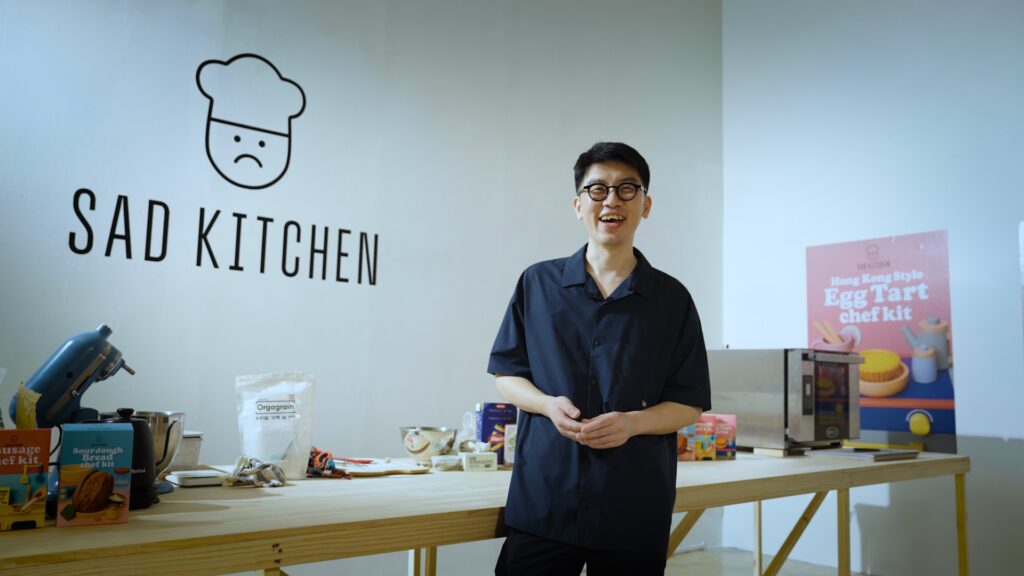
Chapter 03.
경계에 선 예술가,
한국을 향한 탐구시간
Chapter 03.
An Artist on the Threshold,
A Time of Exploration Toward Korea
살라스 퐁은 사회 속 불평등이나 제도의 모순을 정면으로 고발하기보다, 유머와 풍자를 통해 그 문제를 드러낸다. 관객은 그의 작품 앞에서 웃음을 터뜨리지만, 곧 그 웃음이 불편함으로 변한다. 대표작 ‘SAD 예술가직업훈련학교, 빵학과’에서 그는 홈쇼핑 방송을 패러디해 미술품을 판매가 아닌 ‘대여’의 형식으로 소개하며, 예술이 소비재처럼 취급되는 현실을 풍자한다.
이러한 태도는 그가 늘 경계 위에 서 있었던 정체성과 맞닿아 있다. 퐁은 자신을 내부자도 외부자도 아닌 ‘경계인(border crosser)’이라 부른다. 홍콩과 독일, 한국 어디에서도 완전히 속하지 못했던 경험은 그에게 낯섦과 친밀함이 교차하는 독특한 시선을 부여했다. 사회를 관찰하기 위해서는 거리를 유지해야 하지만, 공동체와 관계를 맺기 위해서는 가까이 다가가야 한다는 이 양가적 태도가 그의 작업을 규정한다.
Rather than directly denouncing social inequality or institutional contradictions, Silas Fong reveals them through humor and irony. Viewers often laugh in front of his works, only to feel a subtle unease soon after. In his representative work SAD Artist Vocational Training School, Department of Bread, he parodied home shopping broadcasts by introducing artworks not for sale but for rent, satirizing the reality in which art is treated as a consumer product.
This attitude is deeply connected to his identity as someone who has always lived on the boundary. Fong describes himself as a border crosser, neither an insider nor an outsider. His experiences of never fully belonging in Hong Kong, Germany, or Korea have given him a unique perspective in which familiarity and estrangement coexist. To observe society, one must maintain distance, yet to connect with a community, one must draw near. This dual position defines both his life and his art.

한국에서의 생활은 그에게 새로운 관찰의 렌즈가 되었다. 시장에서 파를 덤으로 얹어주는 손길, 편의점 직원의 짧은 인사 같은 일상은 그에게 하나의 작은 퍼포먼스로 다가왔다. 전시에서는 직접 빵을 구워 주민들과 나누며, 예술이 제도나 선언 이전에 이미 돌봄과 환대의 가치를 품고 있음을 보여주었다. 그는 또한 한국 사회의 ‘눈치’ 문화에 주목한다. 겉으로는 한국만의 특수한 언어처럼 보이지만, 그는 이를 동아시아 전반에서 작동하는 사회적 암호로 읽는다. 홍콩에서 타인의 행동을 눈치로 감지하고, 독일에서 전혀 다른 표현 방식에 부딪히며 느낀 단절감은, 사회적 분위기를 감지하고 번역하는 예술적 감각으로 발전했다.
그의 시선은 홍콩과 한국의 사회 구조를 비교하는 데까지 확장된다. 홍콩이 개인의 문제 제기를 제도적으로 보완하며 빠른 변화를 이끌어가는 사회라면, 한국은 집단 중심의 구조 속에서 개인의 목소리가 집단 전체의 긴장으로 확대되는 경향을 보인다. 그는 이 차이를 “예상 밖이지만 흥미로운 분석의 기반”이라 말하며, 두 사회의 긴장과 균형을 탐구의 재료로 삼는다.
외국인 예술가로서의 위치 또한 그에게 양날의 검처럼 다가온다. 때로는 ‘한국화된 외국인 예술가’로 환영받지만, 또 한편으로는 ‘특권적 외국인’이라는 시선을 마주하기도 한다. 그러나 그는 국적이 아니라 작업으로 평가받을 때 가장 깊은 감사와 울림을 느낀다고 말한다.
“제 예술 세계는 부엌, 교실, 갤러리의 혼합입니다. 때로는 요리하고, 때로는 가르치고, 전시가 끝난 뒤엔 직접 벽을 다시 칠하기도 하죠.”
그의 예술은 특정 장르에 머물지 않는다. 요리의 행위, 가르침의 과정, 전시 이후의 노동까지도 예술의 일부로 포괄한다. 앞으로 ‘Bread Whispers’를 발전시켜 음식이 환대가 되고, 돌봄이 하나의 경제로 전환되는 방식을 탐구하고자 한다. 부엌에서 시작된 일이 가족과 공동체, 교실로 이어질 수 있다는 믿음은 그의 예술이 지향하는 보편성과 확장성을 보여준다.
한국에서의 삶이 자신에게 어떤 흔적으로 남을지 묻자, 그는 잠시 생각에 잠겼다. 아직은 명확히 말하기 어렵지만, 한국이 자신이 가장 오래 머문 해외 생활의 무대이며 당분간 떠날 계획도 없다고 했다. 이곳에서의 시간은 여전히 진행 중이며, 아마 다음 만남에서는 그 답을 조금 더 분명히 전할 수 있을 것이라고 덧붙였다. 그의 말처럼, 살라스 퐁의 예술은 끝나지 않은 여정이다. 웃음 뒤의 불편함, 낯섦 속의 친밀함, 그리고 관계로 확장되는 예술의 힘을 통해 그는 앞으로도 세상에 새로운 질문을 던질 것이다.
Life in Korea became a new lens of observation for him. The addition of a few extra green onions at the market, or a brief greeting from a convenience store clerk, became small performances in his eyes. In one exhibition, he baked bread and shared it with local residents, showing that art holds the values of care and hospitality even before it becomes an institution or a statement.
He also pays attention to Korea’s culture of nunchi, or reading the atmosphere. Though it seems uniquely Korean, he interprets it as a kind of social code that operates across East Asia. The sensitivity he developed in Hong Kong by observing others’ actions, and the sense of disconnection he felt in Germany when confronted with a completely different mode of expression, evolved into an artistic sensibility that perceives and translates social moods.
His perspective now extends to comparing the social structures of Hong Kong and Korea. In Hong Kong, individual voices often lead to institutional change and rapid adaptation, whereas in Korea, collective frameworks can amplify an individual’s voice into social tension. He describes this contrast as “an unexpected yet fascinating basis for analysis” and uses it as material for artistic inquiry into balance and conflict between societies.
His position as a foreign artist also carries dual meanings. At times, he is welcomed as a “Koreanized foreign artist,” yet he is also aware of being viewed as a “privileged outsider.” Still, he says the moments that move him most deeply are when his work is recognized not for his nationality but for its artistic merit.
“My world of art is a mix of kitchen, classroom, and gallery. Sometimes I cook, sometimes I teach, and after an exhibition ends, I repaint the walls myself.”
His practice does not stay within a single genre. The act of cooking, the process of teaching, and even the labor that follows an exhibition are all part of his art. Going forward, he plans to develop Bread Whispers, a project that explores how food can become a form of hospitality and how care can turn into an alternative economy. His belief that what begins in the kitchen can expand into the family, the classroom, and the community reflects the universality and openness that define his art.
When asked what kind of trace his life in Korea will leave, he paused. It is still too early to say, he admitted, but Korea has become the place where he has lived the longest outside his home country, and he has no plans to leave anytime soon. This time, he said, is still unfolding, and perhaps at the next encounter he will be able to give a clearer answer. As he put it, the art of Silas Fong is an ongoing journey. Through laughter that turns to unease, familiarity within strangeness, and the expanding power of connection, he continues to ask new questions of the world.
실라스 퐁
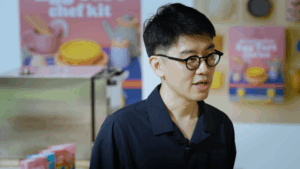
실라스 퐁은 홍콩 출신의 컨템포러리 아티스트로 현재 서울을 기반으로 활동하고 있다. 그는 일상, 사회, 인간관계의 경계를 탐구하며 퍼포먼스와 설치를 중심으로 작업한다. 비디오 아티스트로 출발해 참여형, 장소특정적 프로젝트로 영역을 확장했다. 요리, 빵 나눔, 대화 같은 일상의 행위를 통해 사회 구조를 성찰하고 재해석한다. 대표작 Stolen Times for Sale, Enjoy Your Meal!, SAD 예술가직업훈련학교, 빵학과 등은 현대 사회의 아이러니와 유머를 드러낸다.
Silas Fong

Silas Fong is a contemporary artist from Hong Kong who is currently based in Seoul. He explores the boundaries between everyday life, society, and human relationships through performance and installation. Beginning his career as a video artist, he later expanded into participatory and site-specific projects. Through everyday gestures such as cooking, sharing bread, and conversation, he reflects on and reinterprets social structures. His major works, Stolen Times for Sale, Enjoy Your Meal!, and SAD Artist Vocational Training School, Department of Bread, reveal the irony and humor embedded in contemporary society.
Epilogue
실라스 퐁의 예술은 늘 경계에서 출발합니다. 그는 완전히 속하지 못한 자리에서 낯섦과 친밀함을 동시에 포착합니다. 이 경계의 시선은 때로는 불편하지만 그래서 더욱 예리합니다. 시간을 훔치는 행위, 빵을 굽는 행위, 식탁을 나누는 행위 모두가 그의 손끝에서 예술로 확장됩니다. 웃음을 자아내는 장면은 곧 불편함으로 바뀌고 그 불편함은 다시 질문으로 이어집니다. 예술은 누구에게나 열려 있어야 한다는 그의 믿음은 제도의 언어와 성과 중심의 잣대에 균열을 냅니다.
퐁은 거창한 선언 대신 작은 제스처에서 출발합니다. 한국에서의 경험은 그에게 세상을 다시 바라보게 하는 새로운 렌즈가 됩니다. 시장과 편의점, 빵집과 부엌은 모두 그의 갤러리가 됩니다. 그곳에서 관계는 다시 짜이고, 예술은 나눔으로 변화합니다. 아직 퐁의 여정은 진행 중입니다. 웃음 뒤의 불편함처럼 낯섦 속의 친밀함처럼 그는 앞으로도 경계에서 질문을 던집니다.
Epilogue
Silas Fong’s art always begins at the boundary. From a place where he never fully belongs, he captures both strangeness and intimacy at once. His perspective from this threshold can feel uncomfortable, yet it is precisely that discomfort that sharpens his vision. The act of stealing time, of baking bread, of sharing a meal—all become extensions of art through his hands. Moments that first evoke laughter soon turn into unease, and that unease becomes a question. His belief that art must remain open to everyone disrupts the language of institutions and the measures of achievement that define them.